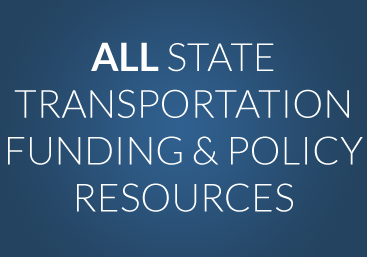Browse the report
POLICY GOALS
- I: Increase accountability and transparency to build taxpayer confidence
- II: Make states economically competitive; empower locals to do the same
- III: Invest in innovation and reward the smartest projects
- IV: Maximize savings through better project development
- V: Improve safety through better street design
Download the full report (pdf)
Join the START Network
T4America supports efforts to produce and pass state legislation to increase transportation funding, advance innovation and policy reform, empower local leaders and ensure accountability and transparency. Join the network.
State policy & funding home
Click here to visit our central hub for all state policy and funding resources, including our work tracking proposals in states to raise new transportation funding or reform the policies governing those funds to improve how those dollars are spent.
Stay informed
Sign up to receive news and updates from T4America. All fields are required.
Goal III: Invest in innovation and reward the smartest projects
OVERVIEW
The transportation projects we choose to fund with our limited dollars need to accomplish multiple goals at once and promise the strongest return on investment possible. It’s no longer advisable — at any level — to invest our dollars in projects that do anything less.
The transportation sector is ripe for innovation, and several states are leading the way on new approaches to awarding funds to the best projects measured on the merits and finding ways to wring every possible bit of value out of our existing infrastructure through low-cost methods to better manage demand or toll limited roadway capacity.
PROPOSAL #7
AWARD FUNDS COMPETITIVELY TO THE BEST MULTIMODAL PROJECTS
As highlighted in previous sections, the majority of federal and state transportation funds are doled out via formula regardless of an agency’s past performance. The benefits that potential projects might bring have no bearing on whether or not they receive funding. Will a dollar spent here reduce congestion or improve safety more than a dollar spent over there? Questions like these are rarely part of the process of awarding transportation funds.
A multimodal competitive transportation fund encourages and rewards transportation agencies for planning more cost-effective projects and measuring the potential benefits. Multimodal competitive grant programs award funding based on the project’s ability achieve a broad set of goals. Using broad criteria such as return on investment, level of non-governmental financing, or improved access to jobs, a project selection committee assesses the competing applications to determine which projects score the highest and will receive funding. Innovation is rewarded and is often required for beating the competition and winning funds.
There are notable examples to emulate. The federal Transportation Investment Generating Economic Recovery (TIGER), Pennsylvania’s Multimodal Transportation Fund and Oregon’s ConnectOregon programs all have proven track records of success.
ConnectOregon was established in 2005 to provide funding for multimodal, non-highway transportation projects, partially because the state’s constitution bars transportation-generated funds from going to non-roadway uses. The state legislature recognized the importance of having a system that provides a range of transportation options and uses this competitive program to meet that goal. The state has successfully awarded five rounds of ConnectOregon funding, with requests for funding from project applicants exceeding available funds by nearly 2.5 times the amount available. On the whole, each dollar competitively awarded to the 240 projects selected has been accompanied by 1.6 dollars from private and other public sources, a ratio that far exceeds typical formula programs as well as the 30 percent cash match required for applicants to receive funds under this program.
This trend isn’t ending anytime soon. In fact, the sixth round of ConnectOregon applications has been received by the Oregon DOT (ODOT) and for the $45 million available the state received 78 applications from local communities and others requesting more than double the amount available.
The Pennsylvania legislature recognized the importance of getting local communities’ support for Act 89, the billion-dollar transportation funding bill in 2013. As one way to bolster local support, legislators created the Multimodal Transportation Fund to award funding on a competitive basis to local roadway, aviation, freight rail, passenger rail, ports and waterways, and bicycle and pedestrian projects in communities across the state. When the expected transportation revenue fully ramps up in the coming years, this fund will provide more than $250 million per year to local communities and private entities to complete economically important multimodal transportation projects, regardless of the type of project.
In its first year, Pennsylvania awarded 86 projects in 35 counties with $84 million in total funding. The state is currently reviewing applications for the second round of awards for this important program.
Oregon’s ConnectOregon and Pennsylvania’s Multimodal Transportation Fund are the most oversubscribed programs offered by these state transportation agencies. This fact encourages applicants to find the lowest cost solution and maximize non-government private funds to support the project. Both support taxpayers in getting the strongest returns for their investments.
PROPOSAL #8
ALLEVIATE CONGESTION THROUGH LOW-COST TRANSPORTATION DEMAND MANAGEMENT
Even if it were physically possible, no region or state has the financial resources to build their way out of the crippling traffic congestion that many places experience. No matter what new investments are planned, we need to more efficiently use our existing infrastructure assets. That’s where transportation demand management has proven to be a powerful solution.
Transportation demand management uses carrots (incentives) and sticks (penalties) to reduce solo driving — the most inefficient use of limited roadway spaces. Demand management includes employee transit pass programs, vanpools, Wi-Fi-enabled motor coach services, last mile shuttle buses from public transportation stations, payroll subsidies and more. Many regions and large employers have developed transportation management associations (TMAs) to provide employees with information on travel alternatives and expand the options available with the goal of making commuting more convenient, reducing congestion and greenhouse gas emissions, improving mobility and the productivity of the workforce, and saving employers money by avoiding costly parking facility costs.
Washington’s Commute Trip Reductions program is a model for other states to use. Enacted in 1991 and updated in 2006, the program requires employers with more than 100 employees at a single worksite in densely populated areas “to implement programs to reduce single-occupant vehicle commuting by employees at major worksites.” Washington DOT (WSDOT) provides technical assistance to employers and local governments, but employers are provided flexibility in developing their unique company plans and programs that adhere to local goals for the program.
The Commute Trip Reduction program works with more 1,050 worksites and 530,000 employees. From 2007 to 2012, the program reduced drive-alone trips for participants by three percent and vehicle miles traveled by participants fell by nearly five percent. The program receives about $3 million annually, but each dollar of that relatively small cost directly leverages 18 dollars in private funds, and brings other indirect benefits like reduced wear on the transportation system and avoided congestion.
PROPOSAL #9
ENCOURAGE TOLLING TO MANAGE TRAFFIC DEMAND AND DELIVER OPTIONS
Tolls are most often used to help finance the construction and reconstruction of our transportation system. However, tolls can (and should), when effectively delivered, support managing travel demand and traffic congestion to best use our limited road capacity and save states and municipalities money.
Variable tolls and high-occupancy vehicle (HOV) lanes on heavily traveled roads discourage drive-alone trips and help wring out extra capacity. However, robust public transportation options must also be present to ensure commuters have other options to travel the corridor and reach their destinations.
Colorado’s FASTER Act of 2009 (SB 09-108) is an example for other states to follow to manage demand for tolled facilities. This bill enables tolling authorities to use toll revenues for public transportation projects, helping to provide more options for commuters. A 2014 executive order requires all future managed lane projects be reviewed for the inclusion of express bus or bus rapid transit service as well.
The model corridor benefiting from the FASTER Act’s enabling legislation are the managed lanes on the US 36 corridor that connects Denver and Boulder, which opened at the beginning of 2016. Through a public private partnership using a design, build, finance, operate, and maintain (DBFOM) agreement, Colorado DOT, Denver RTD, and local governments have completed a new variable-rate tolled lane the length of the corridor, bus rapid transit service with new stations and park and ride facilities, and a commuter bikeway. The tolls will provide a portion of the financing for all three transportation options — automobile, public transportation and biking. And demand will be better managed by going beyond just tolling to providing users of the corridor with more travel options as a result.
Washington, too, is utilizing tolling as means to better manage their facilities and improve transportation options. 90 percent of the state’s transportation congestion occurs in Seattle, according to WSDOT’s annual Corridor Capacity Report. Starting in 2008 with the passage of a high occupancy toll lane pilot (RCW 47.56.403), the state has now implemented three tolling projects on SR 167, SR 520, and I-405. All three accommodate express bus service.
SR 167 opened in 2008 and is one of the nation’s first high-occupancy toll (HOT) lane projects. The HOT lanes use dynamic tolling to maintain travel speed, and carpools, vanpools and transit use the lane for free. In 2014, compared to the free general-purpose lanes, the northbound and southbound HOT lanes saved weekday drivers eight and six minutes respectively on the morning or evening commutes.
The variable toll lanes on SR 520 opened in 2011 with the goals of maintaining travel time, speed and to generate revenue to pay for a planned new SR 520 bridge and associated operating costs. In 2014 — aside from generating the revenue necessary for reconstructing this vital bridge — the express bus service on SR 520 carried the equivalent of 2.2 general purpose lanes of traffic during peak commute periods. Tolling, carpooling and public transportation reduced congestion on SR 167 and SR 520 by 24 percent and 71 percent in 2014 respectively, compared to 2007 pre-recession levels.
Witnessing the success of the early tolled lanes, in 2015 WSDOT opened the I-405 Express Toll Lanes. All three tolled projects are focused on managing travel demand and traffic congestion by providing multiple options for accessing daily destinations.







